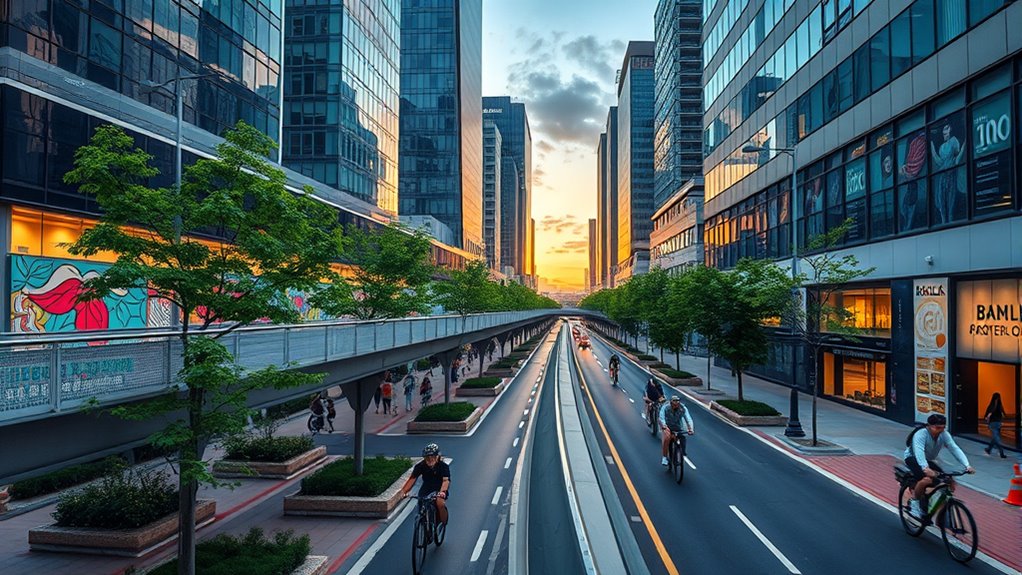Urban cycling has transformed from a recreational activity to a vital part of city planning, shaping safer and more sustainable environments. Initially, bikes helped ease urban congestion, but as concerns grew over pollution and health, cities expanded infrastructure like bike lanes and connected routes. Policies and advocacy further supported cycling’s growth, while technological advances improved safety and convenience. If you keep exploring, you’ll discover how cycling continues to influence innovative city designs and mobility solutions.
Key Takeaways
- Urban cycling evolved from recreational activity to an essential transportation mode, prompting cities to develop dedicated infrastructure.
- Historical shifts, like the rise of automobiles, reduced cycling-friendly policies, but infrastructure expansion revitalized cycling in the late 20th century.
- The reemergence of cycling culture influenced urban planning through policies promoting bike lanes, complete streets, and interconnected cycling networks.
- Cities integrated cycling into sustainable urban mobility initiatives, emphasizing safety, connectivity, and environmental benefits.
- Policy advocacy and community engagement have shaped bike-friendly city designs, reflecting cycling’s growing role in urban planning strategies.
The Early Days: From Novelty to Necessity

In the early days, bicycles shifted from being simply recreational toys or luxury items to essential tools for daily urban travel. During this period, the history of cycling began to influence city planning, even without dedicated infrastructure. Riders navigated crowded streets sharing space with horses and carriages, highlighting the need for better urban infrastructure. In the late 1800s, cities started creating cycling routes that connected parks and entertainment districts, making leisure rides more accessible. As urban congestion increased, bicycles became a popular, affordable, and efficient transportation option. Early advocates recognized their potential to ease traffic and improve mobility. These efforts laid the groundwork for future developments, transforming cycling from a pastime into a crucial component of city life and shaping the evolution of urban infrastructure.
The Mid-20th Century: Decline and the Rise of the Automobile
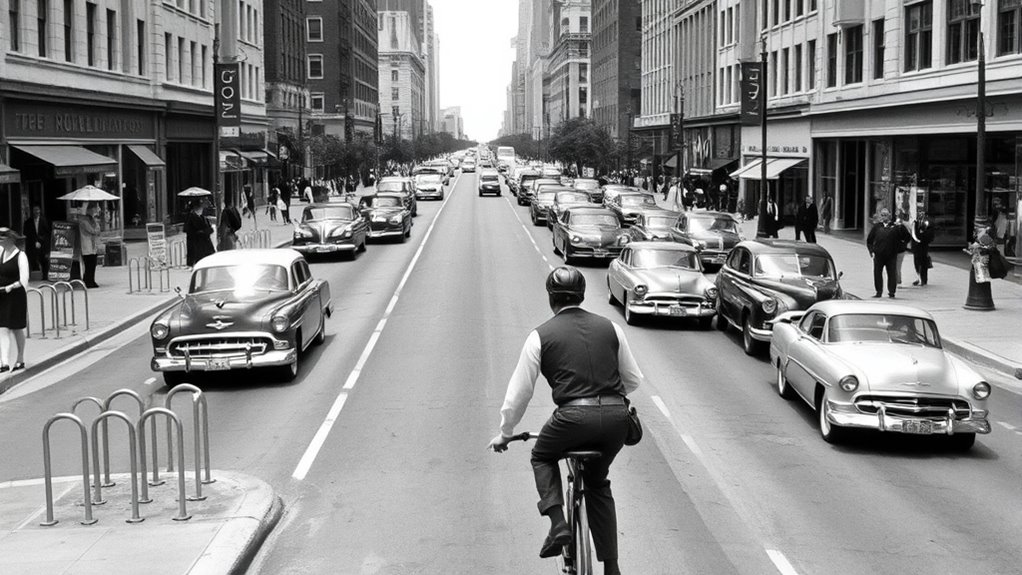
After World War II, urban planning heavily favored automobiles, reshaping city landscapes to prioritize cars over bicycles. Highways, parking lots, and road expansions emerged, marginalizing cycling and reducing cycling infrastructure. Cities redesigned streets to accommodate more vehicle traffic, often removing dedicated cycling lanes and safety features for cyclists. As car ownership increased, the automobile became a symbol of status and convenience, encouraging people to rely less on bicycles for daily commuting. This shift turned cycling from a primary transportation mode into a leisure activity or sport. Consequently, cycling rates declined markedly, and urban environments became less bike-friendly. Urban planning during this period reinforced car dependency, fundamentally transforming city landscapes and diminishing the role of bicycles in daily life. The decline in dedicated cycling infrastructure further hindered the return of bicycles as a primary mode of transportation. Additionally, the lack of integrated urban mobility strategies made it difficult for cycling to regain prominence in city transportation systems. Furthermore, the absence of policies promoting active transportation contributed to the decline in cycling’s popularity within urban environments.
The Renaissance of Cycling in the Late 20th Century
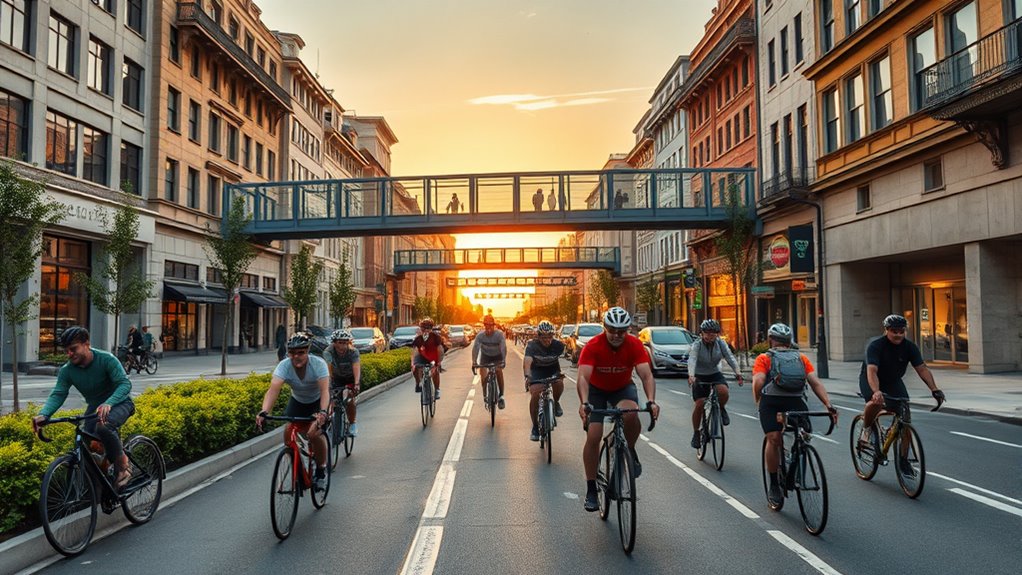
In the late 20th century, environmental concerns and rising fuel costs sparked renewed interest in cycling as a sustainable alternative. Cities responded by expanding infrastructure, creating dedicated bike lanes, racks, and pathways to support this shift. Cycling culture reemerged as a mainstream lifestyle, driven by advocacy, events, and urban policies promoting health and congestion reduction. Additionally, the development of urban cycling infrastructure played a crucial role in making cities more bike-friendly and encouraging more residents to choose cycling. As the forex market operates 24 hours, it exemplifies how rapid globalization influences urban mobility and transportation planning. Moreover, the integration of beauty tips for mask wearers principles into urban planning initiatives can foster community well-being and social cohesion among cyclists and residents alike. Recognizing the importance of best beaches and coastal environments, many cities have also begun to incorporate natural landscapes into their planning to promote outdoor recreation and sustainable tourism.
Environmental Motivations Rise
The late 20th century marked a significant shift in urban cycling, driven largely by growing environmental concerns and economic pressures. People began to see cycling as a practical way to enjoy the environmental benefits of eco-friendly cycling while reducing reliance on cars. Cities responded by investing in dedicated bike infrastructure, such as bike lanes and racks, supporting the push for sustainable transportation. This movement shifted cycling from a recreational activity to an essential urban mode, helping reduce congestion and lower pollution levels. Public campaigns and policy changes emphasized cycling’s role in protecting the environment, encouraging more residents to choose bikes over cars. This renewed focus on eco-friendly travel helped establish cycling as a vital element of city planning and sustainable urban development. Additionally, the integration of renewable energy sources into urban infrastructure has further supported environmentally conscious transportation initiatives. Research indicates that urban planning strategies play a crucial role in promoting active transportation and reducing carbon footprints. Implementing predictive modeling in transportation planning can optimize the development of bike networks and improve their usage efficiency. Moreover, fostering a culture of cycling within communities has been key to sustaining long-term adoption and environmental benefits. Furthermore, advances in urban mobility technology continue to enhance the safety and accessibility of cycling for diverse populations.
Infrastructure Expansion Accelerates
As cities recognized the growing demand for sustainable transportation, they rapidly expanded their cycling infrastructure during the late 20th century. Urban planners prioritized creating exhaustive cycling routes and protected bike lanes to encourage bike use. Major cities like Copenhagen and Portland invested in bike-friendly features such as cycling bridges, bike parking, and dedicated lanes. Technological advancements, including smart sensors and real-time traffic management, improved safety and efficiency on these routes. This infrastructure expansion was driven by environmental concerns, health awareness, and efforts to reduce urban congestion. Additionally, implementing comfort solutions like better seating and surface quality contributed to making cycling more appealing and comfortable for daily commuters. To support this growth, cities adopted policies like “complete streets,” ensuring streets accommodate pedestrians, cyclists, and motorists alike. These improvements made cycling safer, more accessible, and integral to urban mobility, especially when combined with aesthetic hooks and wall organization stylish solutions that enhance urban environments and encourage active transportation. Furthermore, the adoption of business-oriented strategies like public-private partnerships helped fund and sustain infrastructure projects, ensuring long-term urban cycling development. Recognizing the importance of cycling culture, many cities also promoted community events and campaigns to further boost cycling adoption.
Cycling Culture Reemerges
During the late 20th century, a renewed enthusiasm for cycling swept through urban centers, transforming it from a niche activity into a prominent mode of daily transportation. This shift fueled the growth of cycling culture, as cities invested in bike infrastructure like dedicated lanes, racks, and cycling paths. Events such as bike-to-work days and city-sponsored festivals boosted positive perceptions, making cycling more socially accepted and appealing. Environmental concerns, health awareness, and rising fuel costs motivated city planners to incorporate cycling into urban planning strategies, emphasizing “complete streets” and sustainable mobility. As a result, cycling reemerged not just as recreation but as a essential component of urban life, shaping city policies and fostering a community-centered approach to transportation. Additionally, the development of best vacuums for dust removal in 2024 contributed to healthier indoor environments for urban residents, complementing the shift towards cleaner and more sustainable living spaces. Recognizing the importance of leadership skills in managing urban transformation projects has further accelerated the integration of cycling infrastructure into comprehensive city plans.
Reimagining Urban Infrastructure for Cycling

Reimagining urban infrastructure for cycling requires innovative designs that prioritize safety and convenience for cyclists. You’ll see cities integrating protected bike lanes, bike boulevards, and dedicated cycling networks that fit seamlessly into urban design. Successful models like Amsterdam and Copenhagen show the value of continuous, well-connected routes, making cycling safer and more appealing. Implementing “complete streets” policies reallocates space to ensure streets serve all users—cyclists, pedestrians, and drivers—reducing car dominance. Smart technologies, such as sensors and dynamic signage, help manage traffic and enhance safety, encouraging more people to cycle. Additionally, upgrading infrastructure with ample bike parking, secure racks, and transit stations makes multi-modal travel easier and more accessible, reinforcing cycling’s role as a primary urban transportation mode.
Policy and Advocacy Shaping Bike-Friendly Cities
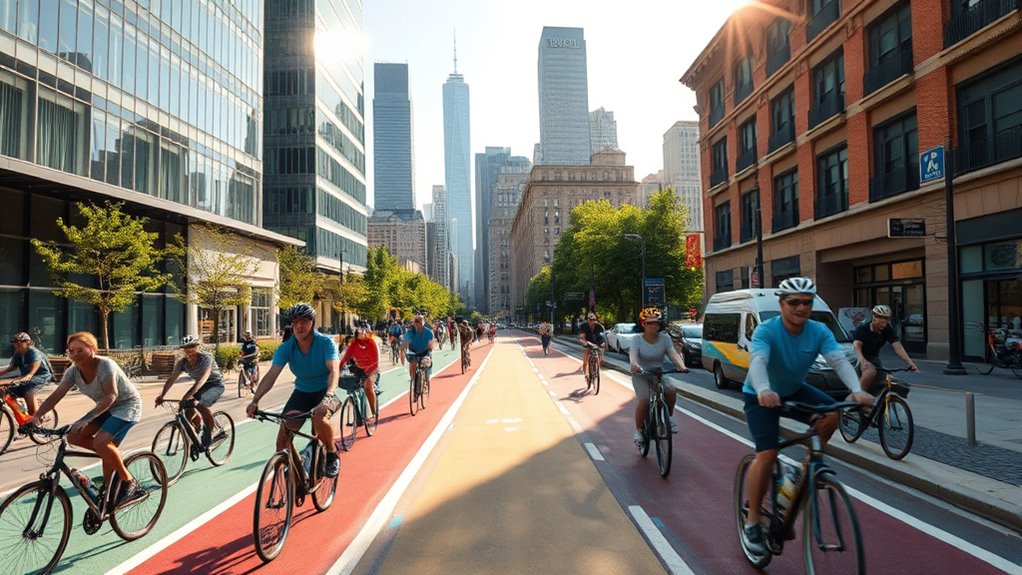
Policy initiatives, advocacy efforts, and legal frameworks play a vital role in transforming cities into bike-friendly spaces. By supporting dedicated infrastructure, safety laws, and community campaigns, you can see real progress in active transportation. These combined strategies help shape policies that make cycling safer and more accessible for everyone.
Policy Drivers for Cycling
Government initiatives, urban planning mandates, and advocacy campaigns are key drivers shaping bike-friendly cities worldwide. These policy drivers focus on expanding cycling infrastructure and integrating cycling into urban planning strategies. Legislation like traffic laws, safety regulations, and dedicated funding have increased bike lane networks and accessibility. Advocacy groups have successfully pushed for policies such as complete streets and dedicated cycling zones, making cycling safer and more convenient. Cities like Copenhagen and Amsterdam exemplify how strategic plans and legislative support can institutionalize cycling as an essential part of urban mobility. Incentive programs, including tax benefits, bike-sharing subsidies, and mobility grants, further encourage cycling adoption. Together, these policy drivers foster environments where cycling becomes a sustainable, accessible, and integral component of city life.
Advocacy and Community Engagement
Community advocacy and grassroots engagement play a crucial role in shaping bike-friendly cities by directly influencing policies and infrastructure development. Through active community engagement, residents have successfully lobbied for expanded cycling infrastructure, like New York City’s over 250 miles of protected bike lanes since 2007. Advocacy efforts, including public campaigns and grassroots movements, have boosted awareness and acceptance of cycling, prompting policy shifts such as Copenhagen’s goal for 50% of trips to be by bike by 2030. Local organizations work with city officials to develop cycling master plans that prioritize community input and equitable access. Additionally, community-led initiatives like bike-share programs and neighborhood cycling events showcase how grassroots engagement can drive policy changes, leading to safer traffic laws and the reallocation of car lanes to prioritize cycling infrastructure.
Legal Frameworks and Safety
When communities rally around bike-friendly initiatives, shaping the legal environment becomes essential for sustained progress. Traffic laws, safety standards, and safety measures create a foundation for secure cycling in cities. You’ll find many cities have enacted laws requiring drivers to share the road and yield to cyclists, reducing accidents. Advocacy groups push for policies like protected bike lanes, bike parking regulations, and incentives such as bike-to-work programs. These efforts influence legislation and urban planning. Key safety measures include helmet laws, street signage, and strict enforcement of traffic violations, which directly protect cyclists. To foster safer, more equitable cities, extensive policies integrate cycling into zoning laws and transportation ordinances. This legal framework is crucial for encouraging cycling and shaping bike-friendly urban environments.
Creating a Cycling Culture Through Urban Design
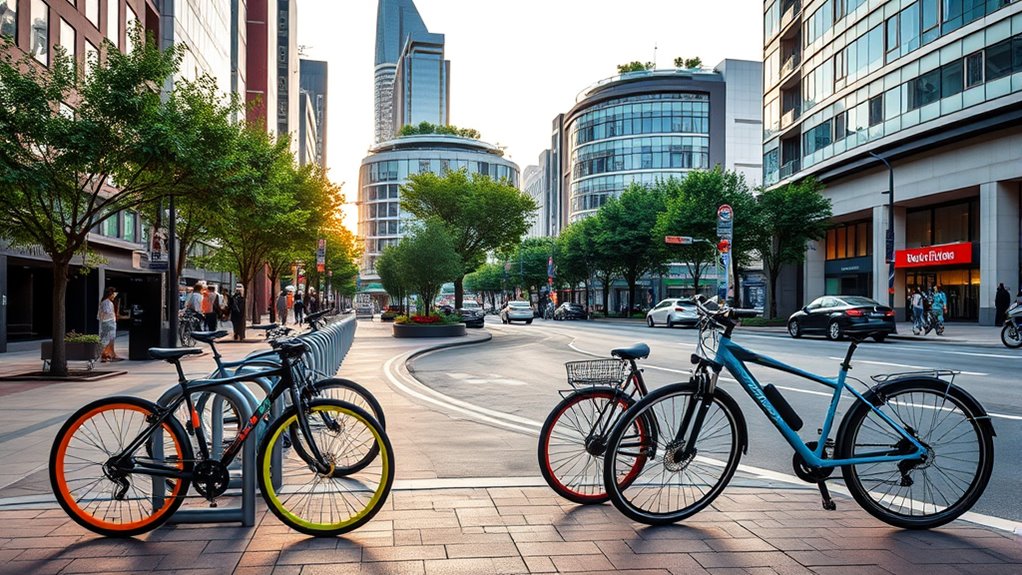
Creating a cycling culture starts with urban design that prioritizes cyclists’ safety and convenience. You can foster this culture by investing in dedicated infrastructure like protected bike lanes, bike parking, and interconnected cycling networks that make riding safer and easier. Urban design strategies, such as “complete streets,” ensure cyclists are included alongside pedestrians and motorists, creating a more inclusive environment. Adding features like wayfinding signage, traffic calming measures, and scenic routes boosts safety and enjoyment, encouraging more residents to cycle regularly. Hosting cycling events and community rides helps normalize biking and builds a social, cultural identity centered around active urban mobility. Designing cities with mixed-use, high-density development around key destinations also shortens trip distances, making cycling a practical and attractive transportation option.
Socioeconomic and Environmental Impacts of Urban Biking
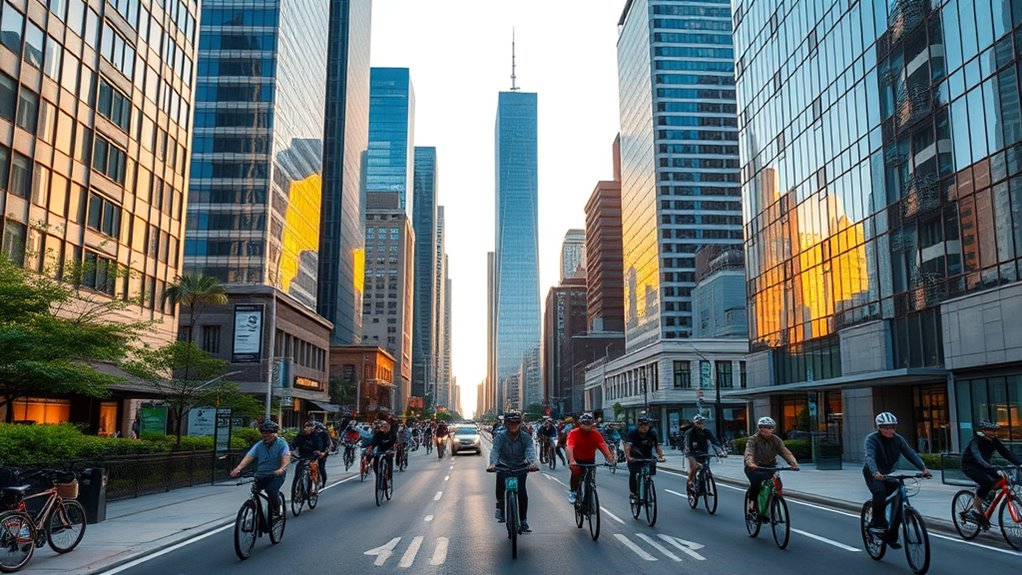
Have you ever considered how urban biking transforms cities beyond just transportation? Cycling offers powerful socioeconomic and environmental benefits that shape sustainable urban development. It reduces air pollution and greenhouse gases, helping cities combat climate change and improve air quality. Cycling also boosts public health by encouraging physical activity, which lowers cardiovascular disease, obesity, and mental health issues. Additionally, investing in cycling infrastructure stimulates local economies through increased foot traffic, job creation, and support for small businesses. Bicycles promote social equity by providing affordable, accessible transportation for low-income and marginalized communities often overlooked by car-centric planning. Overall, urban biking fosters healthier populations, cleaner environments, and more inclusive cities.
- Reduces pollution and greenhouse gases
- Promotes public health and well-being
- Supports economic growth and social equity
Future Trends: Technology and Vision for Sustainable Cities
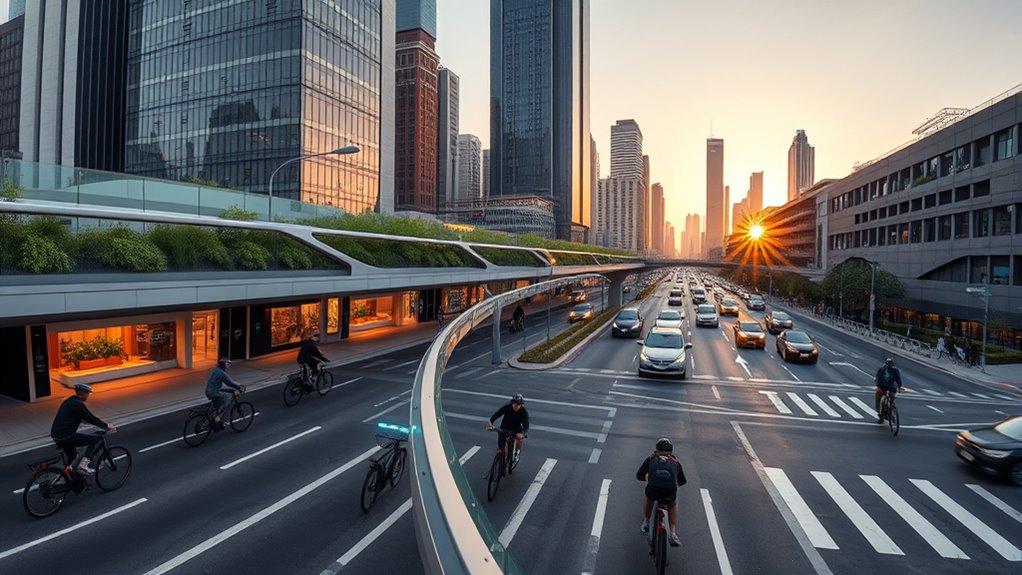
Advancements in technology are shaping the future of urban cycling, making cities more sustainable and rider-friendly. Smart cycling infrastructure, like adaptive traffic signals and connected bike lanes, boosts safety and efficiency for cyclists. E-bikes and cargo bikes are becoming more popular, expanding cycling’s role in urban logistics and daily commuting, helping to cut reliance on cars. Future city plans include creating “15-minute neighborhoods,” where cycling and walking are prioritized for easy access to daily needs. Technologies such as augmented reality helmets and real-time navigation apps further enhance safety and user experience. Globally, cities are integrating cycling into sustainable urban mobility plans, emphasizing better infrastructure, policy incentives, and cultural shifts toward active transportation. These innovations are paving the way for greener, more connected cities.
Frequently Asked Questions
How Have Urban Cycling Policies Evolved Over Different Historical Periods?
You might notice that urban cycling policies have shifted considerably over time. Initially, cities prioritized cars, often neglecting cyclists’ needs. Later, policies began promoting bike infrastructure, safety measures, and dedicated lanes. Today, you see a focus on sustainable transportation, reducing congestion, and encouraging cycling as a healthy, eco-friendly option. These changes reflect evolving attitudes toward urban mobility, emphasizing inclusivity, safety, and environmental impact in city planning.
What Are the Key Challenges in Integrating Cycling Infrastructure Into Existing Cities?
You face several challenges when integrating cycling infrastructure into existing cities. Limited space, traffic congestion, and safety concerns often hinder development. Budget constraints and political resistance can slow progress too. You need to balance the needs of cyclists with those of drivers and pedestrians, ensuring accessibility and safety. Overcoming these hurdles requires careful planning, community engagement, and innovative design solutions to create seamless, cyclist-friendly urban environments.
How Does Cycling Influence Urban Social Equity and Accessibility?
Like threads weaving a tapestry, cycling promotes urban social equity and accessibility by connecting diverse communities. You can see it in how bike lanes make neighborhoods more accessible, especially for those without cars. Cycling reduces transportation costs, empowering low-income residents and fostering inclusion. When cities prioritize bike infrastructure, they create equitable spaces where everyone can move freely, strengthening community bonds and ensuring fair access to opportunities and resources.
What Role Does Technology Play in Modern Urban Cycling Initiatives?
Technology plays a vital role in modern urban cycling initiatives by providing real-time data, route planning, and safety features. You can use apps to find the safest paths, track your rides, and access bike-sharing services easily. Smart sensors and connected infrastructure help improve bike lane safety and maintenance. These innovations make cycling more accessible, efficient, and appealing, encouraging more people like you to choose bikes for daily commuting.
How Can Cities Balance Cycling Needs With Other Transportation Modes?
So, you want your city to juggle cycling, cars, buses, and pedestrians without turning into chaos? Easy! You can prioritize infrastructure for cyclists, create dedicated lanes, and implement smart traffic management. Encourage shared spaces where everyone has a role, and use technology to monitor and adjust. Balance isn’t about giving up; it’s about smart planning and making sure every mode gets its fair ride.
Conclusion
So, as you pedal into the future, remember that urban cycling isn’t just a trend but a revolution—unless you prefer your city gridlocked and polluted. Embrace the bike lanes, advocate for smarter policies, and maybe even swap your car keys for handlebars. After all, if cities are going to survive the traffic chaos and climate crisis, they’d better learn to love the humble bicycle—because nothing says progress like sweating through rush hour on two wheels.
